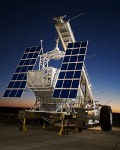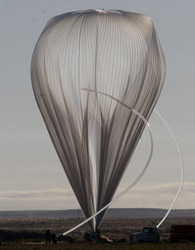Untitled Document
 In a landmark test flight, the National Center for Atmospheric Research (NCAR) and a team of research partners successfully launched a 26.2 cm solar telescope to an altitude of 120,000 feet into the upper reaches of the atmosphere where the sky turns dark, borne by a balloon larger than a Boeing 747 jumbo jet.
In a landmark test flight, the National Center for Atmospheric Research (NCAR) and a team of research partners successfully launched a 26.2 cm solar telescope to an altitude of 120,000 feet into the upper reaches of the atmosphere where the sky turns dark, borne by a balloon larger than a Boeing 747 jumbo jet.
Known as the Sunrise Project, the NASA helium balloon and its attached two-ton gondola of scientific instruments were launched on the morning of October 3, 2007 from the Columbia Scientific Balloon Facility in Fort Sumner, New Mexico. The balloon-observatory reached an altitude of nearly 23 miles (37 kilometers) and remained aloft for about 10 hours, capturing stable solar images, collecting other data of the sun's surface and gathering additional data from the various instruments of the sophisticated payload. At the end of the flight, the gondola separated from the balloon and descended to Earth on a parachute, landing safely in a farm field in Texas.
The Sunrise Project allows researchers to study the structure and dynamics of the magnetic field in the solar atmosphere on small spatial scales for extended time periods by acquiring the highest spatial resolution solar observations ever obtained. The high-resolution images of the sun should lead to a better understanding of that star's role in climate on Earth, and storms on the sun's surface that can affect satellites and communications on Earth. In addition to the solar observations, another key goal of the October 3 flight was to make sure the gondola system held the telescope stable enough to point it at the sun and capture high-resolution images.
One of the most difficult aspects of the engineering work was to design the gondola in such a way that the telescope in flight would remain focused on a specific and relatively tiny area of the Sun, even while twisting on a soaring balloon for a week or longer during the full-scale research missions. To accomplish this, the gondola includes both a torque motor drive to keep the gondola and telescope in the correct orientation and a precision guiding and compensation system to constantly correct the telescope's aim.
A key component of the gondola’s guidance and targeting systems was a high performance PC/104 data acquisition module from Diamond Systems. The DMM-32X-AT analog I/O module features 32 A/D inputs, 4 D/A outputs and 24 digital I/O lines. NCAR engineers used every one of these I/O channels to control the torque motor for proper positioning of the gondola and to manage the guidance and compensation systems for precision aiming of the telescope. The DMM-32X-AT was selected for its large number of I/O channels, programmable automatic calibration of the analog circuits, an operating temperature range of -40oC to +85oC and high tolerance for shock and vibration.
 "From our stand point the flight was as close to perfect as it could be," said an NCAR engineer. The success of the October 3 flight enabled NCAR to move forward with a long-duration polar balloon flight to better study the sun.
"From our stand point the flight was as close to perfect as it could be," said an NCAR engineer. The success of the October 3 flight enabled NCAR to move forward with a long-duration polar balloon flight to better study the sun.
Click here to return to the main article list.